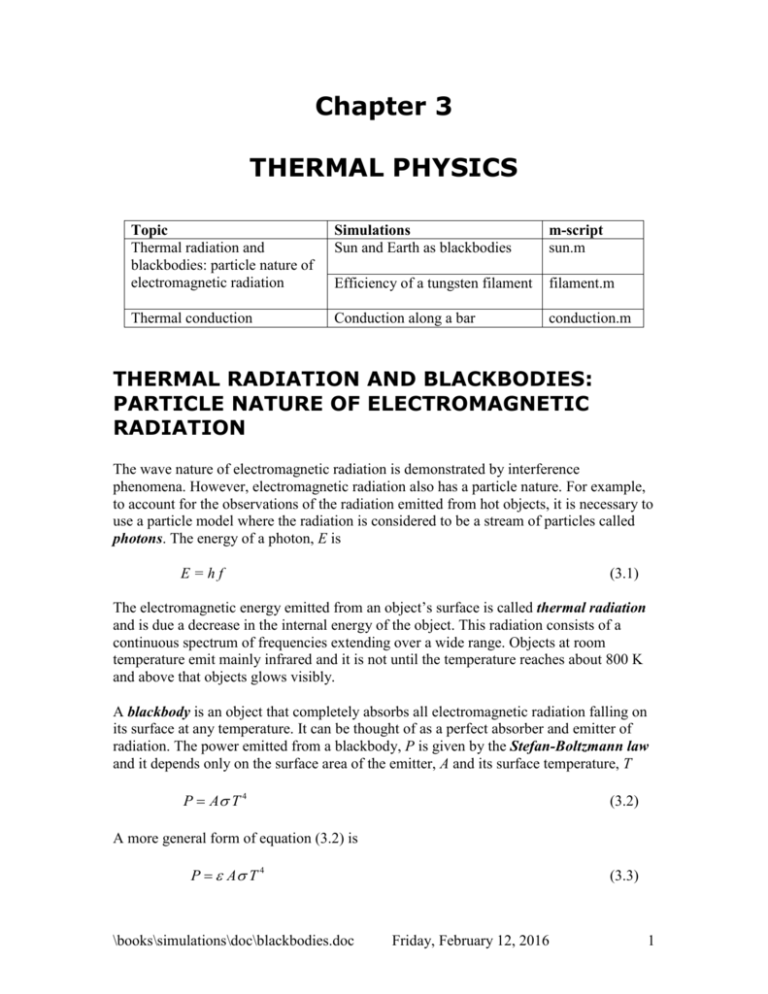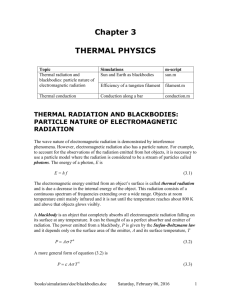blackbodies
advertisement

Chapter 3 THERMAL PHYSICS Topic Thermal radiation and blackbodies: particle nature of electromagnetic radiation Simulations Sun and Earth as blackbodies m-script sun.m Efficiency of a tungsten filament filament.m Thermal conduction Conduction along a bar conduction.m THERMAL RADIATION AND BLACKBODIES: PARTICLE NATURE OF ELECTROMAGNETIC RADIATION The wave nature of electromagnetic radiation is demonstrated by interference phenomena. However, electromagnetic radiation also has a particle nature. For example, to account for the observations of the radiation emitted from hot objects, it is necessary to use a particle model where the radiation is considered to be a stream of particles called photons. The energy of a photon, E is E=hf (3.1) The electromagnetic energy emitted from an object’s surface is called thermal radiation and is due a decrease in the internal energy of the object. This radiation consists of a continuous spectrum of frequencies extending over a wide range. Objects at room temperature emit mainly infrared and it is not until the temperature reaches about 800 K and above that objects glows visibly. A blackbody is an object that completely absorbs all electromagnetic radiation falling on its surface at any temperature. It can be thought of as a perfect absorber and emitter of radiation. The power emitted from a blackbody, P is given by the Stefan-Boltzmann law and it depends only on the surface area of the emitter, A and its surface temperature, T P A T 4 (3.2) A more general form of equation (3.2) is P A T 4 \books\simulations\doc\blackbodies.doc (3.3) Friday, February 12, 2016 1 where is the emissivity of the object. For a blackbody, = 1. When < 1 the object is called a graybody and the object is not a perfect emitter and absorber. The amount of radiation emitted by a blackbody is given by Planck’s radiation law and is expressed in terms of the spectral intensity (radiant emittance) R or Rf R 2 h c2 5 1 hc exp 1 kB T (3.4) or Rf 2 h f 3 c2 1 hf exp kB T (3.5) 1 The power radiated per unit surface of a blackbody, R within in wavelength interval or bandwidth, (1, 2) or frequency interval or bandwidth (f1, f2) given by equations (3.6) and (3.7) 2 2 2 2 h c 1 d P R d 1 1 5 hc exp 1 k T b (3.6) 3 f2 f2 2 h f 1 P R f df 2 f1 f1 c hf exp kb T (3.7) and df 1 The equations (3.6) and (3.7) give the Stefan-Boltzmann law, equation (3.2) when the bandwidths extend from 0 to . Wien’s displacement law states that the wavelength, peak corresponding to the peak of the spectral intensity given by equation (3.4) is inversely proportional to the temperature of the blackbody and the frequency, fpeak for the spectral intensity given by equation (3.5) is proportional to the temperature \books\simulations\doc\blackbodies.doc Friday, February 12, 2016 2 peak b T f peak b f T (3.8) The peaks in equations (3.4) and (3.5) occur in different parts of the electromagnetic spectrum and so f peak c (3.9) peak The Wien’s displacement law explains why long-wave radiation dominates more and more in the spectrum of the radiation emitted by an object as its temperature is lowered. When classical theories were used to derive an expression for the spectral densities R and Rf, the power emitted by a blackbody diverged to infinity as the wavelength became shorter and shorter. This is known as the ultraviolet catastrophe. In 1901 Max Planck proposed a new radical idea that was completely alien to classical notions, electromagnetic energy is quantized. Planck was able to derive the equations (3.6) and (3.7) for blackbody emission and these equations are in complete agreement with experimental measurements. The assumption that the energy of a system can vary in a continuous manner, i.e., it can take any arbitrary close consecutive values fails. Energy can only exist in integer multiples of the lowest amount or quantum, h f. This step marked the very beginning of modern quantum theory. Simulation 3.1 The Sun and the Earth as Blackbodies Inspect and run the m-script sun.m so that you are familiar with what the program and the code does. The m-script calls the functions simpson1d.m and Colorcode.m. The Sun can be considered as a blackbody, and the total power output of the Sun can be estimated by using the Sefan-Boltzmann law, equation (3.2), and by finding the area under the curves for R and Rf using equations (3.6) and (3.7). From observations on the Sun, the peak in the electromagnetic radiation emitted has a wavelength, peak = 502.25 nm (yellow). The temperature of the Sun’s surface (photosphere) can be estimated from the Wien displacement law, equation (3.8). The distance from the Sun to the Earth, RSE can be used to estimate of the surface temperature of the Earth, TE if there was no atmosphere. The intensity of the Sun’s radiation reaching the top of the atmosphere, I0 is known as the solar constant I0 PS 4 RSE 2 (3.10) The power absorbed by the Earth, PEabs is \books\simulations\doc\blackbodies.doc Friday, February 12, 2016 3 PEabs = (1 - ) RE2 I0 (3.11) where is the albedo (the reflectivity of the Earth’s surface). Assuming the Earth behaves as a blackbody then the power of the radiation emitted from the Earth, PErad is PErad 4 RE 2 TE 4 (3.12) It is known that the Earth’s surface temperature has remained relatively constant over many centuries, so that the power absorbed and the power emitted are equal, so the Earth’s equilibrium temperature is 1 I 0 TE 4 0.25 (3.13) Table 1 is a summary of the physical quantities, units and values of constants used in the description of the radiation from a hot object. \books\simulations\doc\blackbodies.doc Friday, February 12, 2016 4 Variable E h c f T A P R Rf kB b bf peak RS RE RSE I0 Table 1. Interpretation energy of photon Planck’s constant speed of electromagnetic radiation frequency of electromagnetic radiation wavelength of electromagnetic radiation surface temperature of object surface area of object Stefan-boltzmann constant power emitted from hot object emissivity of object’s surface radiant emittance (spectral intensity): power radiated per unit area per unit wavelength interval radiant emittance (spectral intensity): power radiated per unit area per unit frequency interval Boltzmann constant Wien constant: wavelength Wien constant: frequency wavelength of peak in solar spectrum radius of the Sun radius of the Earth Sun-Earth radius Solar constant Albedo of Earth’s surface Value 6.6260810-34 2.99792458108 5.669610-8 Unit J J.s m.s-1 Hz K m2 W.m-2.K-4 W (W.m-2).m-1 (W.m-2).Hz-1 1.3806610-23 2.89810-3 2.83 kB T / h J.K-1 m.K K-1.s-1 5.022510-7 m 6.96108 6.96106 6.961011 1.36103 0.30 m m m W.m-2 Summary of the physical quantities used in describing the radiation from hot objects. \books\simulations\doc\blackbodies.doc Friday, February 12, 2016 5 Sample results: sun.m Plots of the spectral intensity curves: 9 x 10 13 Spectral Intensity - Sun 8 Spectral Intensity -1 (W.m ) 7 6 5 4 3 2 1 0 1.4 1 x 10 2 3 wavelength (m) -7 4 5 x 10 -6 Spectral Intensity - Sun Spectral Intensity -2 -1 (W.m .Hz ) 1.2 1 0.8 0.6 0.4 0.2 0 2 4 6 8 10 frequency f (Hz) \books\simulations\doc\blackbodies.doc 12 14 16 x 10 14 Friday, February 12, 2016 6 Matlab screen output: sun.m Sun: temperature of photosphere, T_S = 5770 K Peak in Solar Spectrum Theory: Wavelength at peak in spectral intensity, wL = 5.02e-007 m Graph: Wavelength at peak in spectral intensity, wL = 4.98e-007 m Correspondending frequency, f = 6.02e+014 Hz Theory: Frequency at peak in spectral intensity, f = 3.39e+014 Hz Graph: Frequency at peak in spectral intensity, f = 3.36e+014 Hz Correspondending wavelength, wL = 8.93e-007 m Total Solar Power Output P_Stefan_Boltzmann = 3.79e+026 W P(wL)_total = 3.77e+026 W P(f)_total = 3.79e+026 W IR visible UV P_IR = 1.92e+026 W Percentage IR radiation = 51.0 P_visible = 1.39e+026 W Percentage visible radiation = 36.8 P_UV = 4.61e+025 W Percentage UV radiation = 12.2 Sun - Earth Theory: Solar constant I_O = 1.360e+003 W/m^2 Computed: Solar constant I_E = 1.342e+003 W/m^2 Surface temperature of the Earth, T_E = 254 K Surface temperature of the Earth, T_E = -19 deg C Questions 1.1 How do the peaks in the plots R and Rf compare with the predictions of the Wien displacement law and peak = 502.25 nm (yellow). 1.2 Compare the total solar power emitted by the Sun calculated from the StefanBoltzmann law and by the numerical integration to find the area under the spectral intensity (R and Rf) curves. 1.3 Compare the percentage the radiation in the ultraviolet, visible and infrared parts of the solar spectrum. \books\simulations\doc\blackbodies.doc Friday, February 12, 2016 7 1.4 How does the computed value of the intensity of the radiation reaching the Earth’s surface, IE compare with the solar constant, I0? 1.5 From our simple model, the surface temperature of the Earth was estimated to be -19 oC. Is this sensible? What is the surface temperature on the moon? The average the temperature of the Earth is much higher than this, about +15 oC. Explain the difference. 1.6 What changes occur in the calculations if the Sun was hotter (peak in the blue part of the spectrum) or cooler (peak in the red) part of the spectrum? 1.7 What would be wavelength peak and the temperature of the Sun’s surface if the Earth’s equilibrium temperature was -15 oC instead -19 oC? (In the m-script, increase the value of peak until you reach the required equilibrium temperature of the Earth.) M-script highlights 1.1 Suitable values for the wavelength and frequency integration limits for equations 3.6 and 3.7 are determined so that the spectral intensities at the limits are small compared to the peak values. 1.2 The Matlab function area is used to plot the spectral intensity curves, for example, in plotting the R curve: h_area1 = area(wL,R_wL); set(h_area1,'FaceColor',[0 0 0]); set(h_area1,'EdgeColor','none'); 1.3 The color for the shading of the curve matches that of the wavelength in the visible part of the spectrum. A call is made to the function ColorCode.m to assign a color for a given wavelength band. For the shading of the R curve: thisColorMap = hsv(128); for cn = 1 : num_wL-1 thisColor = ColorCode(wL_vis(cn)); h_area = area(wL_vis(cn:cn+1),R_wL_vis(cn:cn+1)); set(h_area,'FaceColor',thisColor); set(h_area,'EdgeColor',thisColor); 1.4 Simpson’s 1/3 rule is used for the numerical integration (simpson1d.m) to find the area under the spectral intensity curves. For the R curve, the total power radiated by the Sun: P_total = A_sun * simpson1d(R_wL,wL1,wL2); \books\simulations\doc\blackbodies.doc Friday, February 12, 2016 8 1.5 The peaks in spectral intensities are calculated using Matlab logical functions: wL_peak_graph = wL(R_wL == max(R_wL)); f_peak_graph = f(R_f == max(R_f)); \books\simulations\doc\blackbodies.doc Friday, February 12, 2016 9 Simulation 3.2 How efficient is a hot tungsten filament? Inspect and run the m-script filamnet.m so that you are familiar with what the program and the code does. The m-script calls the functions simpson1d.m and Colorcode.m. Blackbodies do not exist in nature. However, simple models are often used that assume an object such as the Sun or an incandescent lamp behave as a blackbody. Some car headlights use a hot tungsten filament to emit electromagnetic radiation. We can estimate the percentage of this radiation in the visible part of the electromagnetic spectrum for a hot tungsten filament that has a surface temperature of 2400 K and an electrical power of 55 W (the thermal power radiated is also 55 W). The first step is to calculate the thermal power radiated by a hot object using equation (3.14) N P A R (3.14) hc exp 1 k T B 5 where N is a normalizing constant and includes a factor for the surface area. Its value is initially set to N = 1. The second step is to numerically integrate P given by equation (3.14) with the limits 1 and 2 so that P1 0 and P2 0. 2 1 1 hc exp 1 kB T PN d (3.15) 5 Determine a new value of N so that the thermal power radiated is, P = 55 W, i.e., the area under the curve for P is 55 W. Recalculate the normalized value of P and plot it. The area under the P curve is shaded yellow to show the visible part of the spectrum. Lastly, the function P is numerical integrated for the limits corresponding to only the visible part of the electromagnetic spectrum 1 = 700 nm (red) and 2 = 400 nm (blue) This gives only the total power radiated in the visible part of the electromagnetic spectrum, Pvisible. The filament efficiency, given as percentage of visible radiation emitted by the hot tungsten filament to the power consumed by the filament Pvisible 100 . P 1 \books\simulations\doc\blackbodies.doc (3.16) Friday, February 12, 2016 10 Sample Results Plot of the spectral intensity curve: 3.5 x 10 Tungsten filament: = 3.5 % 7 3 -1 (W.m ) 2.5 Power / d 2 1.5 1 0.5 0 2 4 6 8 wavelength (m) 10 12 Matlab screen output filament.m wavelength at peak = 1.21e-006 m wavelength at peak = 1.21 um P_total = 55.0 W P_visible = 1.9 W efficiency (percentage) = 3.5 Check normalization P_check = 55.0 W Questions 2.1 Are your surprised by the efficiency of the tungsten filament used in a light globe? 2.2 What part of the electromagnetic spectrum does the peak in the spectral intensity curve occur? \books\simulations\doc\blackbodies.doc Friday, February 12, 2016 11 2.3 Most of the energy emitted from the light globe is not emitted in the visible part of the electromagnetic spectrum. What happens to most of the electrical energy supplied to the light globe? 2.4 What temperature would the filament have to be at so that the peak is in the visible part of the spectrum? Is this possible? 2.5 What is the minimum temperature of the filament so that the globe just starts to glow? 2.6 How do the results change if the power emitted by the hot tungsten filament was 75 W? M-script highlights The highlights for the script filament.m are very similar to the file sun.m. References \books\simulations\doc\blackbodies.doc Friday, February 12, 2016 12







